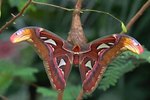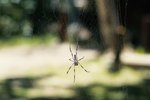
Kansas is known as a butterfly-friendly state, with a national program devoted to the study and conservation of monarch butterflies headquartered at the University of Kansas. Its position as a central state ensures that it is part of the range of a large number of both moth and butterfly species, which means that it has an equally diverse selection of caterpillars.
Web-Producing Caterpillars
The eastern tent caterpillar and the fall webworm are both considered pests in Kansas thanks to their habit of leaving unsightly clusters of webbing on trees and other foliage. The eastern tent caterpillar produces smaller web clusters that sometimes go unnoticed, but their feeding habits are responsible for defoliation of landscapes and orchards in the early spring. Fall webworms are generally considered the greater nuisance due to their tendency to cover large sections of trees and foliage with their webbed nests. Although these webs are unsightly and can temporarily destroy foliage, they generally don't pose a serious health threat to established trees.
Monarch Caterpillar
The familiar orange-and-black monarch butterfly is such a common sight in Kansas that it prompted the University of Kansas to establish a program called Monarch Watch to study the migration and breeding habits of the monarch. Although monarch butterflies generally migrates to Mexico and the Pacific Coast for breeding season, they often stop for a temporary roost in south-central Kansas, leaving behind smooth, yellow, black-and-white-banded monarch caterpillars in their wake. These caterpillars are notable for being able to eat the poisonous milkweed plant, which in turn makes them poisonous to predators.
Hackberry Emperor Caterpillar
The hackberry emperor is another butterfly species so abundant in Kansas that it has drawn the attention of Kansas University. The range of this species extends from northeastern Mexico to Nebraska and is found throughout most Eastern states, with the exception of New England and the northern parts of New York, Michigan and Wisconsin. The adult butterfly has brown-and-tan wings covered in white spots, but as a caterpillar this species has a body covered with short lateral green spines and tiny yellowish bumps. The caterpillar's head is brown on the upper half with a pair of thick, black horns jutting out, and it has two short tails coming out of its rear.
Great Leopard Moth Caterpillar
The great leopard moth caterpillar is a fuzzy black caterpillar common to eastern Kansas. In its larval form it has reddish skin with long black "hair" all over its body, but as an adult it has snow-white wings, the forewings covered in hollow black spots. These caterpillars are found in the Eastern states from Massachusetts to Florida and as far west as Michigan, eastern Kansas, Missouri and Texas. It has a widely varied diet that includes banana trees, cabbage, cherry trees, dandelions and sunflowers.
References
- Great Plains Nature Center: Checklist of Kansas Insects [PDF]
- K-State Research and Extension: Web-Producing Caterpillars in Kansas [PDF]
- The Kansas City Star: Huge number of caterpillars spotted near Lawrence
- University of Florida IFAS Extension: Hackberry Emperor, Asterocampa celtis
- Butterflies and Moths of North America: Attributes of Hypercompe scribonia: Great Leopard Moth
- Great Plains Nature Center: Monarch Butterfly
Photo Credits
-
Jupiterimages/Photos.com/Getty Images
Writer Bio
Jean Marie Bauhaus has been writing about a wide range of topics since 2000. Her articles have appeared on a number of popular websites, and she is also the author of two urban fantasy novels. She has a Bachelor of Science in social science from Rogers State University.



